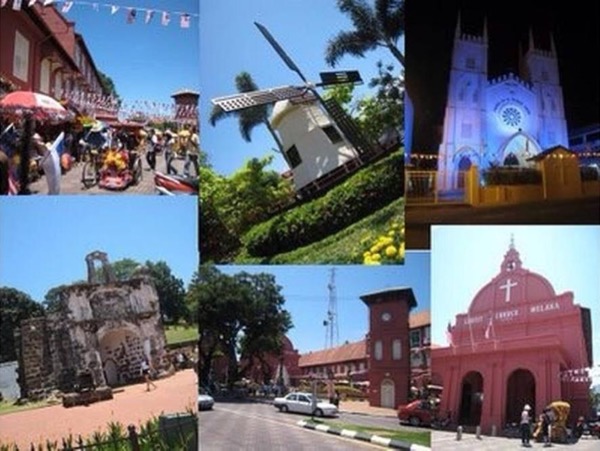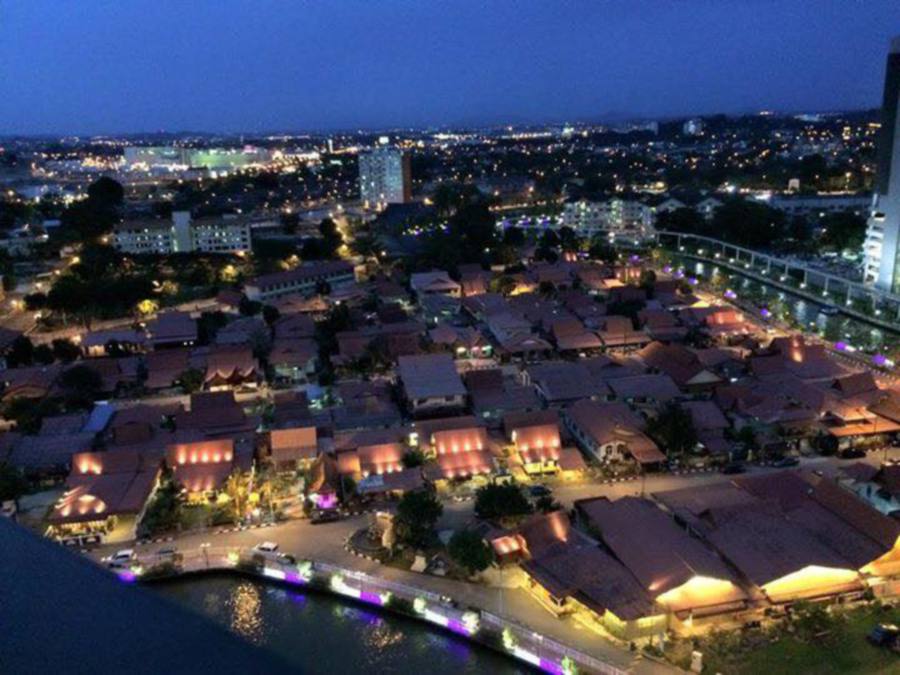A village largely left untouched since the ‘20s, Kampung Morten still retains its identity, writes Loong Wai Ting
IT IS raining heavily when the Uber driver, a chatty fellow, drops us off at the fountain outside of Kampung Morten in the heart of the historic city of Melaka. It takes a while for us to find the famous fountain, the meeting point of the Kampung Morten Cultural and Heritage Guided Walk, as it is located on the far side of the village.
My guide Shaukani Abbas is already waiting for us at a food stall near the fountain. Our tour is supposed to start at 5pm but due to the relentless rain, we decide to sit it out. But half an hour later, we’re still stuck at the stall, where Shaukani offers plan B.
If it continues to rainfor another 10 minutes, we’ll have to come back the next day. As if Mother Nature hears our silent plea for the rain to stop, it finally does 10 minutes later.
As we prepare for the tour, a jovial Canadian couple and two locals from Penang ask if they can join us on our walk. Of course, they can! After all, the more the merrier, no?
The sun is out, there is a rainbow and water puddles on the street reflect the beautiful wooden and brick houses in Kampung Morten. The Melaka River across the street flows steadily, carrying with it fallen branches and dead leaves. Passengers on the river cruise wave as they move past us.
Enclosed by tall buildings and luxury hotels, Kampung Morten is a tiny Malay village, an anachronism that has survived the passing years.
Ironically, with the rapid urbanisation project in Melaka, the village is largely left untouched since the ‘20s. But instead of old village houses connected with stilts, there are now tarred roads.
Like Kampung Baru in Kuala Lumpur, Kampung Morten still preserves its rustic charm and identity.
HISTORY
Back in the day, when the nearby market in Kampung Jawa was forced to make way for a development, its residents soughta place to call home. It was by chance that they came across a swampy plot filled with nipah and mangrove forest and decided to make it their home. But there was a problem: The Hindu Mohammad Endowment Board wanted 10,000 Straits Dollar for the land.
So, the village head Othman and his brother-in-law Demang Abdul Ghani approached the British Land Commissioner Frederick Joseph Morten to secure a loan and subdivided the land into 100 plots.
To thank Morten for his assistance, the villagers named the village after him. As nearby villages changed their names to Malay, Kampung Morten retains its name to pay tribute to the man who helped established their village.
But Othman’s role and contribution to the village have not gone unrecognised. The Melaka State Government honoured him by naming the main street surrounding the village as Persiaran Datuk Othman.
Today, a walk in Kampung Morten is similar to what you would expect in the past, except for better roads and more modern-looking houses.
The population of the village is 900, with 96 houseson the 96-hectare land. In July 2002, the village was gazetted as a Residential Area under the Preservation and Conservation of Cultural Heritage Enactment 1988.
WALKABOUT
Much of the tradition and custom are still retained till today. It’s a delight to watch children playing on the once-narrow streets, cycling past neighbours’ houses, calling out to their friends. Older children who have just got back from religious school join their friends.
Hands on each other’s shoulders, they are not shy to say hello to strangers. A boy comes up to us and shouts “selamat datang” (welcome).
Our first stop is the Herbs Garden Md Jas Jalani. Local herbs and fruit trees grow in abundance around the house. Shaukani introduces to us the various herbs used in curries andsavoury dishes.
I bite into the tart green fruit of the belimbing buluh (similar to star fruit) tree. Next, we marvel at the fresh Vietnamese mint that grows beautifully beside the belimbing buluh tree. As my hand brushes among the plant, I can’t help but salivate at the thought of the piping hot assam laksaand assam pedas.
Continuing the 90-minute tour, we stop at Rumah Merdeka, a house decked in the Jalur Gemilang that flutters in the wind. The Melaka flag is also on each side of the roof of the house.
Before entering the house or the living museum as our guide puts it, we are briefed on the custom before entering a Malay house. It is an eye-opener for the international tourists and a good reminder for locals on the do’s and don’ts of Malay customs.
Upon entering the house, we are greeted by a chatty woman named Aminah Abu Bakar, who was born and raised in the house.
According to Mak Cik Aminah, as she is fondly called, her mother always reminded her children to be thankful for a peaceful country. In fact, she would get angry if her children were late in decorating their house with Malaysia flags.
Every year on the night of independence, she prepared a special menu of boiled tapioca with spicy anchovies, a staple during the war. Shespent RM100 every August to buy and decorate her house with the Jalur Gemilang.
Antique radio and cutlery from yesteryears line glass shelves in the house. Aminah then shows me a glass feeding bottle belonging to her. “I used to drink milk from this bottle when I was small,” she says as she carefully takes it out of the glass cabinet and places it in front of us.
Except for the yellowing pacifier, the bottle looks pristine, as if just bought from a store.
Next, Aminah shows us the correct way to wear the sarung typically worn by men and women in Southeast Asia.
In Malaysia, the sarung is worn during prayers, leisure or simply to enjoy the comfort of the wear.
We are invited to explore Aminah’s home, which has two entrances. The main entrance is for visitors and its male residents, while the back entrance is used by women and children. The house is divided into three areas: serambi (verandah), rumah ibu (main area) and dapur (kitchen).
Some houses have anjung and passageways. Anjung is a covered porch used as a relaxation area for the family and to receive guests. The passageway known as selang links the main house to the kitchen, and in case of fire, it provides an effective escape route. The house is usually built on wooden posts to protect against wild animals, floods as well to provide ventilation.
No tour in Kampung Morten is complete without visiting Villa Sentosa, dubbed The Living Museum by many tourists.
It was built in 1920 by the late Othman, the same man who contributed to the founding of the village but it wasn’t until Hashim Abdul Ghani, who took over the house, that extensive renovation was done to the house. It was officially turned into a museum on Dec 11, 1991.
Since then, nine generations of Othman’s descendents have stayed in this house. Villa Sentosa has a unique interior apart from a collection of Malay traditional wear, musical instruments and antique furniture. Entrance to Villa Sentosa is by donation.
All the 96 houses in Kampung Morten offer homestays. Thirteen offer kampung-style accommodation.
ONE FOR THE ROAD
Before leaving Kampung Morten, I recommend eat your fill of nasi lemak at the famous Nasi Lemak Haji Deraman stall, manned by the man himself, and who has been selling the rice dish for the past 33 years.
The dish comprises rice cooked in coconut milk and screw pine leaves, and served with sambal (chilli paste), fried anchovies, boiled eggs and sliced cucumbers. Side dishes include fried chicken and beef rendang. Commonly wrapped in banana leaves, it is one of the popular items for breakfast. But of course, any true blue Malaysian will tell you that nasi lemak can be eaten any time throughout the day and night.
TIMES Magazine recently listed nasi lemak as one of the top 10 healthiest international breakfast. More reason to tuck in?
DO YOU KNOW...
ONCE a filthy river filled with trash, the Melaka river has gone through a clean-up, thanks to a project by the Danish Cooperation for Environment and Development, a non-profit organisation.
The clean-up, which began in January 1996 with a grant of RM12 million, was divided into two phases: The first lasted for six months to identify the nature of the problem,followed by a two-year phase to collect data to formulate action plans.
The local government, inspired by the river concept in St Antonio River Walk in Texas, US spent RM300 million to beautify the river.
FAST FACTS
KAMPUNG MORTEN CULTURAL AND HERITAGE GUIDED WALK
TEL: 06-282 6526/06-281 2886
HOURS Every Monday, Wednesday and Friday at 5pm. Be there by 4.45pm for registration.
PAY It’s free!
HOW TO GET THERE
It is easier to grab a ride-sharing services or taxi. Just tell your driver where to drop you off as there are a few entry and exit points in the village. The meeting point of the guided walk is at the fountain near a banana fritters stall
















